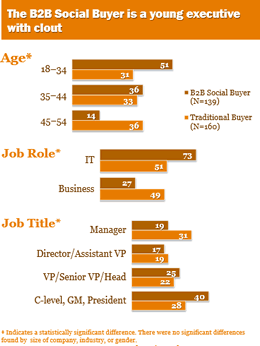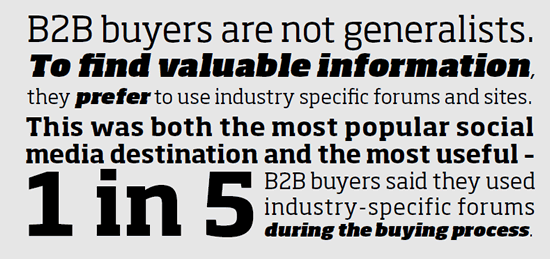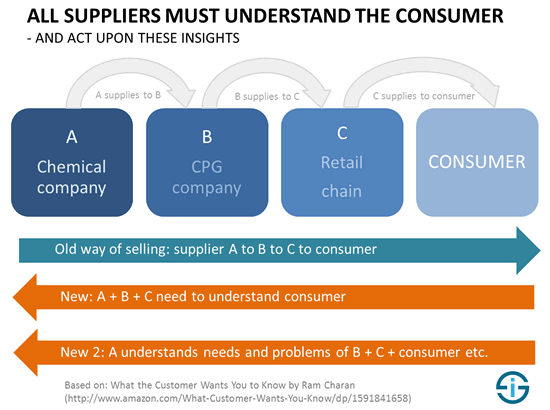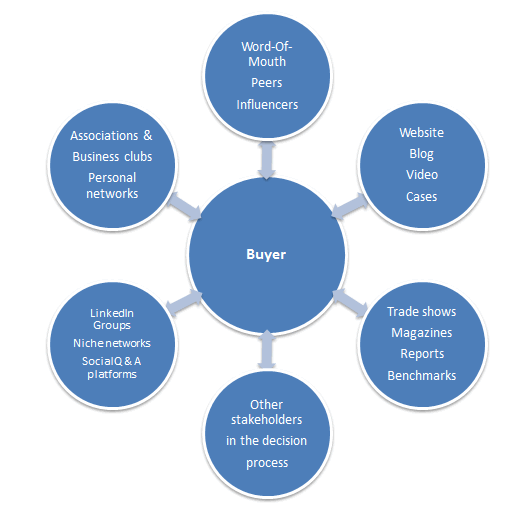
Marketing, sales and other functions have changed. It’s the same in B2B. Contrary to popular belief, B2B decision makers are using social media marketing and social media across their B2B buying journey. The misperception that social media is a ‘consumer thing’, is caused by the fact that most research focuses on social channels and evolutions in B2C markets.
It’s wrong to believe decision makers don’t use social media across their connected buyer’s journey, they just use them differently (with even more differences depending on profile, age, type of business and…personality, to name just a few) for business purchases than for private reasons (wih many overlaps).
Just as there is a new breed of consumers known as the ‘connected consumer’ who relies heavily on digital and social technologies, there is a group of ‘heavy social media users’ in B2B, known as the ‘Social B2B buyer’ as the ITSMA (Information Technology Services Marketing Association), serving a specific vertical B2B niche, called him.
In the end, let’s not forget that B2B buyers are consumers too. Moreover, there is a clear difference between the B2B buyer’s adoption of social media depending on age as year after year is shown in the (European) BuyerSphere Report (see presentation below and/or download the PDF) and it’s obvious social-savvy buyers gradually grow older.
Finally, let’s not forget that often the B2B buying journey is a collaborative one: a group decision, involving multiple stakeholders and decision makers.
Another reason for the misperception that social is just a ‘consumer thing’ is the fact that most literature looks at marketing goals that are more typical in business-to-consumer tactics and certainly at the social channels that are used in B2C with a clear focus on the ‘latest and hottest’ platforms. It’s important to look beyond that hype. While it’s probably less sexy to talk about blogs, LinkedIn, customer communities, niche platforms and relationship marketing than about Twitter, Facebook or ‘the next big thing’, it’s more valuable to achieve our goals. Let’s look deeper into the core success factors of a social B2B approach.
Here are a few lessons to start with:
- Lesson number 1: it’s integrated. Email and search today are still the main digital touchpoints in the B2B buying journey.
- Lesson number 2: social in B2B is a lot about finding the right content at the right time (content marketing).
- Lesson number 3: social in B2B is a lot about industry-specific communities, professional networks, trust, proximity and moving towards personal interaction.
- Lesson number 4: branding and emotions matter. The B2B decision journey is more ‘rational’ but don’t underestimate the power of brand and emotion, an often made mistake. While B2B decisions tend to be less impulsive they’re certainly also less rational than we seem to believe.
Aside from all these lessons and all possible tips let’s look at the essence of any social strategy in B2B (and beyond as well as it also goes in B2C to a certain extent and is about more than just social). It’s the customer-centric and de facto social mindset and strategy of understanding what the customer wants you to know…

The value chains in B2B sales and marketing
In 2007, highly sought after business guru Ram Charan published “What the Customer Wants You to Know: How Everybody Needs to Think Differently About Sales“. Before social media and its’ effects on the buyer’s choices even existed, Charan wrote “We have to face the truth: the process of selling is broken. Customers have more choices and are under intense pressure. Yet few companies are facing this reality. When they don’t, a lingering malaise sets in.”
Just as the process of selling is broken, marketing is broken. The only way to fix it is by putting what the customer wants you to know – and do – first. This time, it’s really about getting up close and personal, with the needs of the customer in mind rather than pushy messages. The key to success lies in aligning goals and customer needs, while understanding the channels and types of content that work best for each need and business phase.
In the book Charan emphasizes that this new way of sales is across the whole value chain. The social media space is one of different value chains and influence spheres as well. In order to achieve business goals, very often these different ‘social chains’ need to be reached and that’s exactly what you can do with social media. Using social media you can not only understand the needs, pains and behavior of your customers, their customers etc. as Charan advises (see image below, based upon Charan’s book) but you can also turn these insights into action. Note how Charan mentions that this also means all suppliers must learn consumer insights. What better way to do it than using social listening, in combination with other feedback systems? And can we understand the consumer if we don’t know the social and digital technologies he uses?

One of the typical characteristics of social media is the ripple effect: content and stories get posted and shared via different channels and by several people, resulting in different ripples at the same time that enhance each other. It results in what we know as buzz or virality. It’s this effect, however, that enables you to reach more people in the value chain. Obviously, depending on your goals and other aspects, you need to prioritize this.
Charan wrote the prophetic words “Someday, every company will listen more closely to the customer, and every manager will realize that sales is everyone’s business, not just the sales department’s”. Understanding the challenges of the customer and how their business works so you can help them make it work better is essential. This is not only the case in pure business interactions. A journalist will only write about you if you understand what challenges he faces and how you can help him, for instance, by sharing unique and relevant stories his audience and publisher will like.
Charan advised businesses to become their “customer’s trusted partner, someone he can turn to for creative, cost-effective solutions that are based on your deep knowledge of his values, goals, problems, and customers”.
Some ways, to do it, as he described them on his website:
- Gain a deeper knowledge of your customer’s problems.
- Understand how your customer’s company really makes decisions.
- Help your customer improve margins and drive revenue growth.
- Connect sales with other key functions.
- Come up with new customized offerings.
What Charan basically did, was describing how selling shifted to buying, how crucial it became to get a better understanding of the customer, build trust, act in a bi-directional way (dialogues) and focus on developing stronger relationships. This leads to more business and greater involvement with the customer’s business. The focus is to help your customer realize his goals by making his customers realize theirs, etc.

Getting sales out of its isolation and connecting it with other key functions was another significant evolution that today is reality. Finally, customization – and thus personalization – was the clear need of a more educated and demanding customer. When reading between the lines, you might notice that the role of social media in B2B was predicted in Charam’s book, as was the evolution of other forms of marketing, such as content marketing, in general. In fact, understanding how the success of the customers of your customers (interpreting customers in the broadest possible sense) is what social media marketing success, social collaboration success and virtually all forms of integrated marketing and social business in a connected age are all about and – to be honest – have always been about. It’s the common golden rule of social media in B2B and B2C. It’s also the common golden rule in social business and many other areas. Social media enabled businesses to realize many of the ‘changing rules and practices’. Even better: it added several other opportunities Charam couldn’t foresee.
From selling to decision facilitation in the B2B buying journey
Let’s look at the evolutions Charam described and those we witness since the advent of social media as explained here. Despite the fact that a B2B buyer is also a consumer, the differences between B2B and B2C marketing remain (be it, again, with many overlaps). Usually B2B marketing is more relational and personal to start with, certainly in our business.
Whether we look at it from a customer acquisition, customer retention, up-selling or loyalty perspective, we need to shift our focus from selling the old-fashioned way to selling by enabling the buying process.
This requires taking – prospective and existing – customers by the hand by offering value at the right moment and right place. It’s about building close and personal relationships by mapping what buyers need, what we have to offer and how we can get them to connect both. The same rules and mechanisms apply in all marketing tactics, including social. There are several reasons to do so. Firstly, remember the clear shift from selling to buying on the customer behavior level. But, in the end, selling should always be about understanding how people buy and turning their personal feedback and digital ‘footprints’ into (more) sales.
What really changed in recent years are the steps and influencing factors buyers take during the decision process and when actually deciding.
A few examples:
- Relevant and consistent multi-channel experiences.
- Social proof and recommendations.
- Valuable content, adapted to individual needs and the phase of the customer life cycle.
- Word-of-mouth and influential opinions.
- Socially networked relationships and communities
That’s what social buzzwords such as ‘engagement’, ‘content marketing‘, ‘participation’ and ‘conversations’ are really about.
Many businesses have social media strategies that focus on sales, using intermediary steps such as blog marketing, demand generation, lead generation and lead nurturing in a connected marketing automation and CRM context. However, it’s important to partially reverse that view (yes, we still sell as well). If we look at social media as buyer tools, rather than marketing tools, we will work in a more efficient, personal/relational and customer-centric way. In a way, we should turn the social media hub and spoke model in an integrated and social buying hub and spoke model with the end-to-end customer experience and the life cycle stage (e.g. pre-purchase) at the center.
While this model is simple and can also be applied to other circumstances and types of relationships, it’s important to remember how the goals of the customers in the broadest sense come first and how they use different channels and touch points, depending on their purpose and personal traits.

